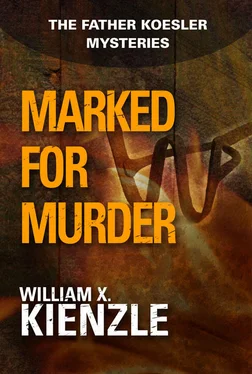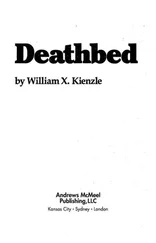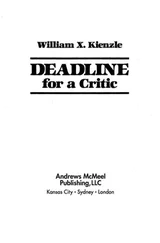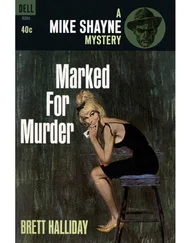It was Koesler’s secondary reaction that caused him to object strenuously: “But if Father Kramer was intoxicated, he couldn’t possibly have committed that murder!”
From what Kramer had described as a Sunday routine of drinking until stupefied, Koesler’s concept was of a man so drunk he would lie wherever he dropped. And he could not understand why Inspector Koznicki couldn’t immediately understand this.
“Oh, no, Father,” Koznicki insisted, “such is by no means always the case. People who are intoxicated can and do perform all sorts of actions. They drive—often successfully; sometimes, tragically, not. They work through an afternoon and evening after drinking too much at lunch. It goes on and on. Intoxicated people are, simply, unpredictable. Some collapse and sleep it off. Others go on with daily activity, sometimes impaired, sometimes more keenly. In fact, one might argue that, not infrequently, drink takes away natural inhibitions. Thus, if Father Kramer were intent on committing such a heinous crime, alcohol might repress his conscience.”
Koesler considered this. And, in the end, rejected it. There was, of course truth in what the inspector said. But none of what he said fit Dick Kramer. The impossibility was that Kramer ever would be more “intent” on murdering someone. Not even possibly.
“Well,” Koesler said, “if I’m going to begin, I’d better get over to the medical examiner’s office. And . . . thanks for your time and direction.”
As Koesler left his office, Koznicki prepared to make calls—first Mangiapane as an escort, then Moellmann to prepare him for the visit. He watched as his priest-friend disappeared around a corner, and wondered what it would take before Koesler would be forced to abandon his quest—which, at this point, really was an impossible dream.
34
This was Father Koesler’s first visit to the Wayne County Morgue. As familiar as he was with downtown Detroit he had never paid any attention to the squat square building tucked in between Bricktown and Greektown. Nor had he ever adverted to the grisly procedures that were the regular course of business there. Now that officer Mangiapane had ushered him into the vast gray interior of the main floor, consideration of what was going on downstairs was inevitable. And creepy.
Mangiapane introduced Koesler to the receptionist, who gave him a genuine, if surprised, smile. Priests were not frequent visitors at the morgue. Once in a long while, one might come in to identify a corpse. But even with some dispute among Catholic theologians as to when the soul departs the body, all would agree that the morgue was beyond the purview of the Sacrament of the Sick.
“Inspector Koznicki just phoned, Father,” the receptionist said. “I sent the message down to Dr. Moellmann. He should be up here any minute now. He was just about done.”
As she finished speaking, the sound of voices entered the lobby. Two men and a woman appeared. The woman and one of the men wore white coats. Koesler presumed, correctly, that the two were pathologists and that one had to be Dr. Wilhelm Moellmann. The man in plainclothes Koesler already knew to be Lieutenant Tully.
Mangiapane’s introduction of Koesler to Tully was interrupted. “We’ve met,” said Tully. “Sorry to run off, Father, but I’ve got lots of work to do.” With that, he was gone.
Shortly, the woman, too, was gone, leaving Koesler and Moellmann standing alone together.
Moellmann scrutinized Koesler. “So,” he said (it came out “tzo”), “so this is the Father Koesler. I’ve heard about your work with the police.” Emphasizing the article made Koesler sound like an instant celebrity. If the tactic was intended to disconcert and put the priest on the defensive, it worked, at least to some degree. For a moment, Koesler was speechless. Then, “Someone’s pulling your leg, Doctor. I don’t work with the police.”
“One keeps one’s ear to the ground, one hears things.”
To Koesler, Moellmann seemed to be translating from a more familiar German even as he spoke. But Koesler had heard of Moellmann, too. He was, according to popular reputation, one who jokingly pulled legs unmercifully. But, at the core, he was one of the very best pathologists in the business.
Moellmann led the way up the marble steps toward the second floor and his office. “Tell me, Father Koesler . . .” The “oe” of Koesler’s name became an umlaut; somehow it pleased the priest. “. . . what is your interest in this case? What brings a priest, of all people, to get involved in a murder so messy?”
“A priest is accused of these ‘messy’ murders.”
“So?”
“So I don’t think he did them.”
Moellmann’s face expressed more surprise than Koesler’s statement merited. That, thought Koesler, must be part of the performance.
“Lieutenant Tully thinks the priest is guilty,” the M.E. stated.
“I don’t.” It was said a bit more forcefully than was Koesler’s habit. Perhaps he was playing along with Moellmann.
“And you don’t!” Moellmann’s wonderment seemed unfeigned. “Lieutenant Tully is an excellent detective. I have never known him to be this convinced and not be correct.”
“Every rule has its exception. But if I’m going to help my friend, Father Kramer, I’ll need all the help I can get—particularly since, as you say, Lieutenant Tully is so convinced he’s guilty. That’s why Inspector Koznicki sent me to you.” Koesler hoped the implication was obvious. From Moellmann, Koesler needed information, not discouragement.
“Very well.” Moellmann led the way into his inner office. He proceeded to go through his file cabinets, extracting rather full manila folders, to which he added the one he had carried from the basement. He put all of them on the desk between himself and Koesler. “There, that’s it. The current ‘Case of the Mutilated Prostitutes.’” He then proceeded to arrange photos and charts on the desk.
Koesler looked about as if searching for some specific something.
“What is it, Father? What are you looking for?”
“The tapes.”
“The tapes? What tapes?”
“Don’t you tape-record your autopsies?”
“Tape—? Oh, you mean like Quincy and all those medical examiners you see on the television?”
“Well, yes.”
Moellmann grinned. “No. No, I have a body chart at each body and I make all notations on that chart. Then when I come up, I fill in all the details while they are still fresh in my mind. Each person works according to his upbringing. You know? In Goethe’s Faust, it says someplace in there . . . eh . . . ‘The way he coughs, the way he spits’—in German it rhymes—‘he has copied the boss.’ So no one here—all eight doctors here—no one dictates. Everybody does the same as I do.”
Koesler nodded understanding as he tried to absorb the enormity of the violence depicted in these pictures.
Moellmann watched Koesler intently. The priest didn’t realize it, but he was undergoing a test. He could stomach studying these pictures—or he might become physically ill. Moellmann would continue his help only if Koesler was not upset at the horror exhibited.
Koesler was surprising himself in keeping everything down and quiet.
“You see,” Moellmann said, “I have the police make sure that I get a set of the scene pictures because I want the whole file, the whole case all together.”
“These are all pictures the police have taken, then?”
“No, no. I have our photographer take more pictures. You see, I take more interest in these bodies than in all the others—arteriosclerosis and stabbings and shootings. Because these are a ritual and they are more interesting, I spend more time with these. Make very definitive diagrams, drawings, and be very explicit so I don’t lose anything in translation. And I make sure that they are photographed very adequately. Not only for documentation, but also for purposes of teaching. Because you don’t see this often.”
Читать дальше












